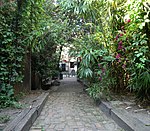Charles M. Schwab House
1906 establishments in New York CityBuildings and structures demolished in 1947Châteauesque architecture in the United StatesDemolished buildings and structures in ManhattanFull-block apartment buildings in New York City ... and 4 more
History of ManhattanHouses completed in 1906Houses in ManhattanUpper West Side

The Charles M. Schwab House (also called Riverside) was a 75-room mansion on Riverside Drive, between 73rd and 74th Streets, on the Upper West Side of Manhattan in New York City. It was constructed for steel magnate Charles M. Schwab. The home was considered to be the classic example of a "white elephant", as it was built on the "wrong" side of Central Park away from the more fashionable Upper East Side.
Excerpt from the Wikipedia article Charles M. Schwab House (License: CC BY-SA 3.0, Authors, Images).Charles M. Schwab House
West 73rd Street, New York Manhattan
Geographical coordinates (GPS) Address Nearby Places Show on map
Geographical coordinates (GPS)
| Latitude | Longitude |
|---|---|
| N 40.7811 ° | E -73.9845 ° |
Address
West 73rd Street 306
10023 New York, Manhattan
New York, United States
Open on Google Maps








